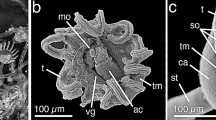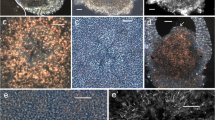Summary
The tentacle of Rhabdopleura compacta (Hemichordata) consists of two layers of cells surrounding a central coelomic cavity. The two layers of cells are separated by a cell free basement lamella.
The tentacles on the arms of Rhabdopleura bear three longitudinal rows of cilia. The ciliated cells are closely associated with bundles of nerve fibres, and between some of the cells and nerve fibres there are synapses. The peripheral regions of the ciliated cells are joined to one another by desmosomes. Tonofibrils join some of these desmosomes to the kinetosomes of the cilia.
The nerve fibres are confined to the ectodermal layer and the muscle cells to the layer of cells within the basement lamella. In the ectodermal layer besides ciliated cells there are mucus cells, densely pigmented cells, and green bodies. The function of these last two types of cells is secretory. Most of the epithelial cells have microvilli upon their free borders.
Similar content being viewed by others
References
Barber, V. C., Dilly, P. N.: Some aspects of the fine structure of the statocysts of the molluscs Pecten and Pterotrachea. Z. Zellforsch. 94, 462–478 (1969).
Burdon-Jones, C.: The biology of Rhabdopleura normani (Allman). Challenger Soc. 3, No 9 (1957).
Chun, C.: Die Ctenophoren des Golfes von Neapel und der angrenzenden Meeres-Abschnitte. Leipzig 1880.
Cobb, J. L. S.: The significance of the radial nerve cords in asteroids and echinoids. Z. Zellforsch. 108, 457–474 (1970).
Dilly, P. N.: The nerve fibres in the basement membrane and related structures in Saccoglossus horsti (Enteropneusta). Z. Zellforsch. 97, 69–83 (1969).
Eimer, T.: Über Beroë ovatus. Zoologische Studien auf Capri. I. Leipzig 1873.
Gray, E. G.: Tissue of the central nervous system. In: Electron microscopic anatomy (S. M. Kurtz, ed.). New York: Academic Press 1964.
Horridge, G. A., Mackay, B.: Neurociliary synapses in Pleurobrachia (Ctenophora). Quart. J. micr. Sci. 105, 163–174 (1964).
Knight-Jones, E. W.: Relations between metachronism and the direction of ciliary beat in metazoa. Quart. J. micr. Sci. 95, 503–521 (1954).
Lane, B. P., Rhodin, J. A. G.: Cellular interrelationships and electrical activity in two types of smooth muscle. J. Ultrastruct. Res. 10, 470–488 (1964).
Lankester, E. Ray.: A contribution to the knowledge of Rhabdopleura. Quart. J. micr. Sci. 24, 622–647 (1884).
Mackie, G. O.: Conduction in the nerve-free epithelia of siphonophores. Amer. Zoologist 5, 439–453 (1965).
Parker, G. H.: The movements of the swimming plates in ctenophores, with reference to the theories of ciliary metachronism. J. exp. Zool. 2, 407–423 (1905).
Reynolds, E. S.: The use of lead citrate at high pH as an electron-opaque stain in electron microscopy. J. Cell Biol. 17, 208–212 (1963).
Schepotieff, A.: Die Anatomie von Rhabdopleura. Zool. Jb. 23, 463–534 (1907).
Schneider, K. C.: Einige histologische Befunde an Coelenteraten. Jena. Z. Naturw. 27, 379–462 (1892).
Stebbing, A. R. D.: Discovery of Rhabdopleura (Hemichordata) at Plymouth. Nature (Lond.) 217, 1284 (1968).
Stebbing, A. R. D.: Aspects of the reproduction and life cycle of Rhabdopleura compacta (Hemichordata). Marine Biol. 5, 205–212 (1970).
Verworn, M.: Studien zur Physiologie der Flimmerbewegung. Pflügers Arch. ges. Physiol. 48, 149–180 (1891).
Author information
Authors and Affiliations
Additional information
I wish to thank Professor J. Z. Young F. R. S. for enthusiastic advice and encouragement. Dr. R. Bellairs generously provided the facilities for electron microscopy. Mr. R. Moss gave excellent technical and photographic assistance. Dr. A. Stebbing of the Plymouth Marine Biological Laboratory helped me to obtain and to identify the specimens. Professor D. W. James kindly allowed me to use his facilities for interference microscopy.
Rights and permissions
About this article
Cite this article
Dilly, P.N. The structures of the tentacles of Rhabdopleura compacta (Hemichordata) with special reference to neurociliary control. Z. Zellforsch 129, 20–39 (1972). https://doi.org/10.1007/BF00307107
Received:
Issue Date:
DOI: https://doi.org/10.1007/BF00307107




